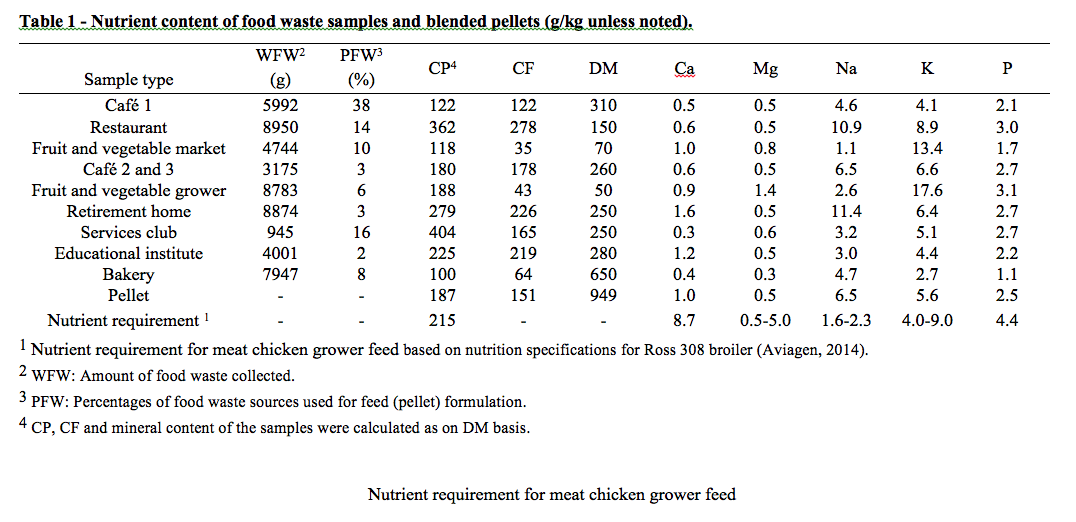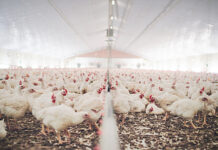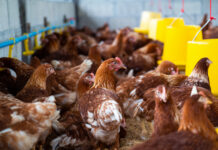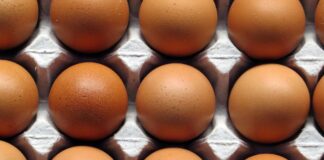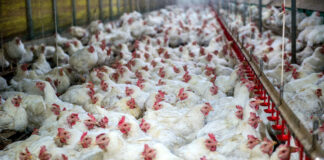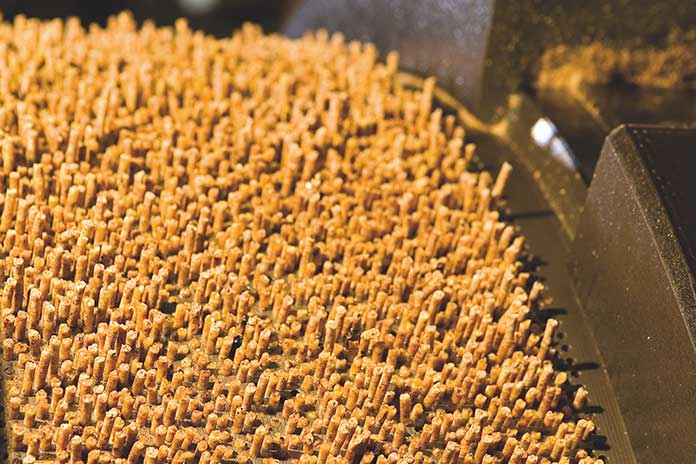
The annual food waste in Australia is estimated at 7.5 million tonnes with the majority disposed of in landfills. This not only causes significant economic loss but also has a negative environmental impact. This study aimed at investigating the possibility of recycling food waste into feed for poultry.
Nutrient contents of various waste streams were evaluated. The food waste collected from the services club and restaurant contained the highest levels of crude protein and crude fat (404 g/kg and 278 g/kg, respectively) while crude protein and crude fat content of food waste originating from bakeries and fruit-vegetable growers were 100 g/kg and 43 g/kg, respectively. The findings indicated that the blended material had an excessive Na concentration (6.5 g/kg), low Ca content (1.0 g/kg) and high/low concentrations of other nutrients relative to broiler grower feed requirements. Further studies are required to investigate the blending of waste streams with other nutrient sources to meet nutrient requirements. Microbial contamination, free fatty acids, oxidation and nutrient digestibility need to be considered before valuable recycled food wastes can be used as a feed source for poultry.
Introduction
Food waste refers to “the discarding or alternative (non-food) use of food that was fit for human consumption – by choice or after the food has been left to spoil or expire as a result of negligence”. It is estimated that the global economic loss caused by food waste is US$ 1 trillion annually. The wasted amount of cereals, root crops, fruits and vegetables, fish, oilseeds, meat and dairy products in the food industry has been estimated to be between 20 to 50% each year. In Australia, the annual wasted food has been estimated to be 7.5 million tonnes equivalent to a loss of US$8 billion in 2014. The Australian national food waste report in 2016 showed that the quantity of food waste sent to landfills was greater than any other disposal system in 2014-2015, representing 58% of total food waste generation. When food is wasted, the costs related to the production, packaging, delivery, selling and preparation of that food is also lost. Furthermore, food waste ending up in landfills can cause serious environmental impacts. Some authors indicated that recycling of food waste as wet or a dry pig feed resulted in better environmental and public health outcomes than other food waste disposal methods such as composting and anaerobic digestion. As the world’s population is predicted to increase to 9.8 billion by 2050 food waste will increase proportionally suggesting the opportunity to further examine systems for recycling. In some Asian countries like Japan and South Korea, where the demands for animal feed are high, the recycling of food waste as animal feed is popular and is supported by local laws. Among the food waste sources, food dregs like bean curd or shochu dregs are the most common material being used to produce animal feed in Japan, which is followed by misdated food from supermarkets, bread, noodles and similar products. In Australia, although the food waste based feed is a new concept, the use of animal origin protein sources as poultry feed is not restricted by government legislation and thus is a potential area to develop. The main objective of the current study was to investigate nutrient levels in Australian food waste streams for use as poultry feed.
Methods
Nine food related businesses, educational institutions and hospitals in the Hawkesbury district, NSW, Australia were requested to participate in the study with food waste collected over a 2 hour period (either 10am to 12 noon or 12 to 2pm) on agreed days. Most of these collections were carried out between March and June 2017. Samples were collected from 9 commercial operations such as, cafes, restaurants and bakeries. Buckets were provided with instructions to fill with kitchen scraps, serving waste and plate scraps. At the end of the 2 hour period, the buckets were collected and transported to the Hawkesbury campus of Western Sydney University in a refrigerated container for processing and producing food waste pellets. Only one sample was collected from each commercial operation. Hence, the consistency of the sample collected from each of the commercial operations was not checked. Collected food waste was screened to remove foreign objects with initial weights of all samples recorded. Food waste suppliers were de-identified and given general classifications, e.g. restaurant, hospital and supermarket. Food waste was heat treated on trays to 90oC with steam for 10 min, then dehydrated at 70°C for 30 hours in a large commercial dehydrator cabinet and ground to pass through a 3 mm screen. The powdered samples were analysed for moisture, crude protein (CP), crude fat (CF), calcium (Ca), magnesium (Mg), sodium (Na), potassium (K) and phosphorus (P) and blended to produce extruded pellets. Pellets were produced by blending food waste samples with water (56:44) to produce a dough that was then passed through a Bottene pasta extruder to create 3mm x 6mm pellets. Pellets were dehydrated for 24 hours at 70°C. The nutrient content of feed pellet samples including dry matter (DM), moisture, CP, CF, Ca, Mg, Na, K and P and ash content were analysed. This procedure is further described in Australian patent 2018100266.
Results
The nutrient content of food waste samples and extruded pellets are presented in Table 1. The dry matter yield of different food waste sources ranged from 5% (fruit and vegetable waste) to
65% (bakery waste). The CP and CF contents were variable between the waste samples. Food waste collected from the services club and restaurant contained the highest levels of CP and CF (404 g/kg and 278 g/kg, respectively) while CP and CF contents of food waste originating from the bakeries and fruit-vegetable growers were 100 g/kg and 43 g/kg, respectively. Blended pellets were shown to have 187 g/kg CP and 151 g/kg CF (Table 1). The findings also indicated that final blended pellets had a high Na concentration (6.5 g/kg) and a low Ca content (1.0 g/kg) relative to nutrient requirements for meat chickens (Table 1).
Discussion
Feed is the most significant cost of poultry production. Much of this is attributed to the protein/amino acid content. The results of the current study indicate that food waste may be able to supply a significant amount or all of the protein required for poultry feed. Further testing is required to assess nutrient consistency over time from each source. The protein content of the food waste sample collected from the services club was 404 g/kg being similar to that of other high protein ingredients used in the feed industry. Furthermore, some authors pointed out that significant feed cost reduction (32.9%) can be obtained when 50% of food waste mixture, containing restaurant food waste, bakery by-product and broiler litter, was incorporated into the normal diet for finishing pigs compared to the control ($0.57 vs $0.85/kg weight gain).
More work needs to be done to determine digestible amino acid content of food waste and the cost of food waste based feed in Australia. In addition, as the quantity of food waste might change between the regions and seasons of the year, further studies on availability of food waste in defined areas is necessary to determine the reliability and sustainability of waste streams as a continuing material source. The fat and Na content of blended food-waste was higher and calcium was lower than broiler grower requirements. Free fatty acids, oxidation and metabolisable energy need to be considered. Variability is an issue that needs consideration as indicated by various research groups. However, solutions to solve this problem have been rarely mentioned in those studies. Processing method might play an important role in maintaining nutritional composition of the food waste. Some authors found that chemical composition of food waste dehydrated by fry cooking ranged from 1.2 – 1.8% only. In addition, it has been suggested that, when garbage food waste is collected from numerous origins and blended, nutrient variability will decrease. It is proposed that the issues associated with nutrient variation in the food waste based feed can be addressed through measurement and blending of various waste streams and incorporation of other ingredients such as amino acids, limestone, phosphate, vitamins, trace minerals, antioxidants and antifungal agents. There is a good agreement between nutrient values obtained in the current study and those reported by some authors who reported dry matter, CP and CF contents of restaurant food waste on DM basis to be 191 g/kg, 220 g/kg and 126 g/kg, respectively and bakery by-product were 890 g/kg, 95 g/kg and 20 g/kg, respectively. Other reports have indicated fat and protein contents of restaurant waste to be higher (17.3% and 25%, respectively) and metabolisable energy level to be lower (2344 Kcal ME/kg) compared to the nutrient requirement for meat chickens. In contrast, bakery waste is rich in energy but has low protein and mineral levels. Importantly, other authors pointed out that the general hygiene and chemical safety of food waste feed produced in China were good with low risks of pathogen and organic contamination but the product safety related to salt concentration was rather low.
The variable CP and high sodium contents observed in the food waste based feed in this study can be solved by applying processing methods that blends various waste streams to produce an optimum final product to be used on a commercial scale. To achieve this optimum blend, further data collection and analysis are required.
References available on request
From the proceedings of the 2019 Australian Poultry Science Symposium


